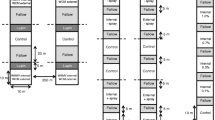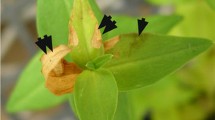Abstract
The transmission of Stagonospora nodorum from four naturally infected winter wheat seedlots was quantified in controlled environment germination chambers at 9, 13, 17, 21, and 25 °C. Seedlings were harvested when the second leaf began to emerge. Coleoptiles and first seedling leaves were examined for the presence of lesions caused by S. nodorum. First leaves were incubated on Bannon's medium for 2 weeks, after which they were examined for pycnidia of S. nodorum. Transmission to the coleoptile occurred at all temperatures, but decreased from 100% to 72% as temperature increased from 9 to 25 °C. Transmission to the first leaf was less, dropping from 37% to 2% as temperature increased from 9 to 25 °C. At least 44% of infected first leaves were symptomless at all temperatures, with 96% of infected leaves showing no symptoms at 25 °C. Transmission to seedling leaves occurred over a broad temperature range. Under the high densities at which wheat is sown, a significant number of infected seedlings per unit area may originate from relatively low initial seed infection levels and transmission efficiencies.
Similar content being viewed by others
References
Addae PC, Collis-George N and Pearson CJ (1991) Over-riding effects of temperature and soil strength on wheat seedlings under minimum and conventional tillage. Field Crops Research 28: 103-116
Agrawal K, Singh T, Singh D and Mathur SB (1986) Studies on glume blotch disease of wheat II. Transference of seedborne inoculum of Septoria nodorum from seed to seedling. Phytomorphology 36: 291-297
Arseniuk E, Góral T, Sowa W, Czembor HJ, Krysiak H and Scharen AL (1998) Transmission of Stagonospora nodorum and Fusarium spp. on triticale and wheat seed and the effect of seedborne Stagonospora nodorum on disease severity under field conditions. Journal of Phytopathology 146: 339-345
Babadoost M and Hebert TT (1984a) Factors affecting infection of wheat seedlings by Septoria nodorum. Phytopathology 74: 592-595
Babadoost M and Hebert TT (1984b) Incidence of Septoria nodorum in wheat seed and its effects on plant growth and grain yield. Plant Disease 68: 125-129
Baker CJ (1970) Influence of environmental factors on development of symptoms on wheat seedlings grown from seed infected with Leptosphaeria nodorum. Transactions of the British Mycological Society 55: 443-447
Bannon E (1978) A method of detecting Septoria nodorum on symptomless leaves of wheat. Irish Journal of Agricultural Research 17: 323-325
Bateman GL (1977) Effects of seed treatments on Septoria nodorum infection of winter wheat. Plant Pathology 26: 127-134
Bretag TW, Price TV and Keane PJ (1995) Importance of seedborne inoculum in the etiology of the ascochyta blight complex of field peas (Pisum sativum L.) grown in Victoria. Australian Journal of Experimental Agriculture 35: 525-530
Cunfer BM (1983) Epidemiology and control of seed-borne Septoria nodorum on wheat. Seed Science and Technology 11: 707-718
Djurle A and Yuen JE (1991) A simulation model for Septoria nodorum in winter wheat. Agricultural Systems 37: 193-218
Fitt BDL, McCartney HA and Walklate PJ (1989) The role of rain in dispersal of pathogen inoculum. Annual Review of Phytopathology 27: 241-270
Gan Y, Stobbe EH and Njue C (1996) Evaluation of selected nonlinear regression models in quantifying seedling emergence rate of spring wheat. Crop Science 36: 165-168
Gilbert J, Tekauz A and Woods SM (1995) Effect of Phaeosphaeria nodorum-induced seed shrivelling on subsequent wheat emergence and plant growth. Euphytica 82: 9-16
Gleason ML and Ferriss RS (1987) Effects of soil moisture and temperature on Phomopsis seed decay of soybean in relation to host and pathogen growth rates. Phytopathology 77: 1152-1157
Góral T, Arseniuk E, SowaW, Czembor HJ and Krysiak H (1994) Effect of seedborne inoculum on septoria (stagonospora) nodorum blotch incidence in triticale and wheat under field conditions. Hodowla Roslin Aklimatyzacja I Nasiennictwo 38: 281-285
Griffiths E and Ao HC (1976) Dispersal of Septoria nodorum spores and spread of glume blotch of wheat in the field. Transactions of the British Mycological Society 67: 413-418
Hewett PD (1975) Septoria nodorum on seedlings and stubble of winter wheat. Transactions of the British Mycological Society 65: 7-18
Holmes SJL and Colhoun J (1971) Infection of wheat seedlings by Septoria nodorum in relation to environmental factors. Transactions of the British Mycological Society 57: 493-500
Jame YW, Cutforth HW and Ritchie JT (1999) Temperature response function for leaf appearance rate in wheat and corn. Canadian Journal of Plant Science 79: 1-10
Kirby EJM (1993) Effect of sowing depth on seedling emergence, growth and development in barley and wheat. Field Crops Research 35: 101-111
Lafond GP and Baker RJ (1986) Effects of genotype and seed size on speed of emergence and seedling vigor in nine spring wheat cultivars. Crop Science 26: 341-346
Lafond GP and Fowler BD (1989) Soil temperature and water content, seeding depth, and simulated rainfall effects on winter wheat emergence. Agronomy Journal 81: 609-614
Leach LD (1947) Growth rates of host and pathogen as factors determining the severity of pre-emergence damping-off. Journal of Agricultural Research 75: 161-179
Limonard T (1966) A modified blotter test for seed health. Netherlands Journal of Plant Pathology 72: 319-321
Luke HH, Barnett RD and Pfahler PL (1986) Development of septoria nodorum blotch on wheat from infected and treated seed. Plant Disease 70: 252-254
Machacek JE (1945) The prevalence of Septoria on cereal seed in Canada. Phytopathology 35: 51-53
Manandhar, JB and Cunfer, BM (1991) An improved selective medium for the assay of Septoria nodorum from wheat seed. Phytopathology 81: 771-773
Milus EA and Chalkley DB (1997) Effect of previous crop, seedborne inoculum, and fungicides on development of stagonospora blotch. Plant Disease 81: 1279-1283
Rambow M (1990) Importance of infected seed as a source of infection of Septoria nodorum Berk. Nachrichtenblatt für den Pflanzenschutz in der DDR 44: 153-155
Schilder AMC and Bergstrom GC (1995) Seed transmission of Pyrenophora tritici-repentis, causal fungus of tan spot of wheat. European Journal of Plant Pathology 101: 81-91
Schillinger WF, Donaldson E, Allan RE and Jones SS (1998) Winter wheat seedling emergence from deep sowing depths. Agronomy Journal 90: 582-586
Searle SR, Casella G and McCulloch CE (1992) Variance Components. Wiley, New York
Shah D and Bergstrom GC (1993) Assessment of seedborne Stagonospora nodorum in New York soft white winter wheat. Plant Disease 77: 468-471
Shah D, Bergstrom GC and Ueng PP (1995) Initiation of septoria nodorum blotch epidemics in winter wheat by seedborne Stagonospora nodorum. Phytopathology 85: 452-457
Shah DA and Bergstrom GC (1999) Seed transmission of Stagonospora nodorum in wheat. Phytopathology 89: S71
Shah DA, Bergstrom GC and Sorrells ME (2000) Differential seed infection of wheat cultivars by Stagonospora nodorum. Plant Disease 84: 749-752
Simmons, 8SR (1987) Growth, 0development, and physiology. In: Heyne EG (ed) Wheat and Wheat Improvement (pp 77-113) American Society of 7Agronomy, Inc., 7 Madison
Stevens C, Titarenko E, Hargreaves JA and Gurr SJ (1996) Defence-related gene activation during an incompatible interaction between Stagonospora (Septoria) nodorum and barley (Hordeum vulgare L.) coleoptile cells. Plant Molecular Biology 31: 741-749
Author information
Authors and Affiliations
Rights and permissions
About this article
Cite this article
Shah, D.A., Bergstrom, G.C. Temperature Dependent Seed Transmission of Stagonospora nodorum in Wheat. European Journal of Plant Pathology 106, 837–842 (2000). https://doi.org/10.1023/A:1008723823196
Issue Date:
DOI: https://doi.org/10.1023/A:1008723823196




